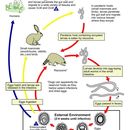en
names in breadcrumbs


The suborder Ascaridina contains the bulk of the Ascaridida, parasitic roundworms with three "lips" on the anterior end. The Ascaridida were formerly placed in the subclass Rhabditia by some, but morphological and DNA sequence data rather unequivocally assigns them to the Spiruria. The Oxyurida and Rhigonematida are occasionally placed in the Ascaridina as superfamily Oxyuroidea, but while they seem indeed to be Spiruria, they are not as close to Ascaris as such a treatment would place them.[1]
These "worms" contain a number of important parasites of humans and domestic animals, namely in the superfamily Ascaridoidea.
The Ascaridina contain the following superfamilies and families:[2]
The suborder Ascaridina contains the bulk of the Ascaridida, parasitic roundworms with three "lips" on the anterior end. The Ascaridida were formerly placed in the subclass Rhabditia by some, but morphological and DNA sequence data rather unequivocally assigns them to the Spiruria. The Oxyurida and Rhigonematida are occasionally placed in the Ascaridina as superfamily Oxyuroidea, but while they seem indeed to be Spiruria, they are not as close to Ascaris as such a treatment would place them.
These "worms" contain a number of important parasites of humans and domestic animals, namely in the superfamily Ascaridoidea.